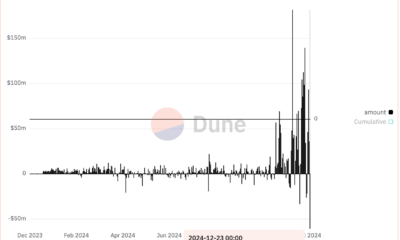Opinion
Revolutionizing Bitcoin Mining: The Power of Three-Phase Systems
Published
3 months agoon
By
admin
Bitcoin mining has seen exponential growth since the first ASIC miner was shipped in 2013, improving hardware efficiency from 1,200 J/TH to just 15 J/TH. While these advancements were driven by better chip technology, we’re now reaching the limits of silicon-based semiconductors. As further efficiency gains plateau, the focus must shift to optimizing other aspects of mining operations—particularly the power setup.
Three-phase power has emerged as a superior alternative to single-phase power in bitcoin mining. With more ASICs being designed for three-phase voltage input, future mining infrastructure should consider adopting a uniform 480v three-phase system, especially given its abundance and scalability across North America.
Understanding Single-Phase and Three-Phase Power
To comprehend the significance of three-phase power in bitcoin mining, it’s essential first to understand the basics of single-phase and three-phase power systems.
Single-phase power is the most common type of power supply used in residential settings. It consists of two wires: one live wire and one neutral wire. The voltage in a single-phase system oscillates sinusoidally, providing power that reaches a peak and then drops to zero twice during each cycle.
Imagine you are pushing a person on a swing. With each push, the swing moves forward and then comes back, reaching a peak height and then descending back to the lowest point before you push again.
Just like the swing, a single-phase power system has periods of maximum and zero power delivery. This can lead to inefficiencies, especially when consistent power is required, although this inefficiency is negligible in residential applications. However, it becomes significant in high-demand, industrial-scale operations like bitcoin mining.
Three-phase power, on the other hand, is commonly used in industrial and commercial settings. It consists of three live wires, providing a more constant and reliable power flow.
In the same swing analogy, imagine you have three people pushing the swing, but each person is pushing at different intervals. One person pushes the swing just as it starts to slow down from the first push, another pushes it a third of the way through the cycle, and the third person pushes it two-thirds of the way through. The result is a swing that moves much more smoothly and consistently because it’s being pushed continuously from different angles, maintaining a constant motion.
Similarly, a three-phase power system ensures a constant and balanced power flow, resulting in higher efficiency and reliability, particularly beneficial for high-demand applications like bitcoin mining.
The Evolution of Bitcoin Mining Power Requirements
Bitcoin mining has come a long way since its inception, with significant changes in power requirements over the years.
Before 2013, miners relied on CPUs and GPUs to mine bitcoins. The real game-changer came with the development of ASIC (Application-Specific Integrated Circuit) miners as the bitcoin network grew and competition increased. These devices are specifically designed for the purpose of mining bitcoins, offering unparalleled efficiency and performance. However, the increased power requirements of these machines necessitated advancements in power supply systems.
In 2016, a top-of-the-line miner was capable of computing 13 TH/s with a power consumption of approximately 1,300 watts (W). While considered highly inefficient by today’s standards, mining with this rig was profitable due to the low network competition at that time. However, to generate meaningful profits in today’s competitive landscape, institutional miners now rely on rigs that demand around 3,510 W.
The limitations of single-phase power systems has come to the fore as the power requirements of ASIC and the efficiency demands of high-performance mining operations grows. The transition to three-phase power became a logical step to support the growing energy needs of the industry.

480v Three-Phase in Bitcoin Mining
Efficiency First
480v three-phase power has long been the standard in industrial settings across North America, South America, and other regions. This widespread adoption is due to its numerous benefits in terms of efficiency, cost savings, and scalability. The consistency and reliability of 480v three-phase power make it ideal for operations that demand greater operational uptime and fleet efficiency, especially in a post-halving world.
One of the primary benefits of three-phase power is its ability to deliver higher power density, which reduces energy losses and ensures that mining equipment operates at optimal performance levels.
Additionally, implementing a three-phase power system can lead to significant savings in electrical infrastructure costs. Fewer transformers, smaller wiring, and reduced need for voltage stabilization equipment contribute to lower installation and maintenance expenses.
For example, a load requiring 17.3 kilowatts of power at 208v three-phase would need a current of 48 amps. However, if the same load is supplied by a 480v source, the current requirement drops to just 24 amps. This halving of the current not only reduces power loss but also minimizes the need for thicker, more expensive wiring.
Scalability
As mining operations expand, the ability to easily add more capacity without major overhauls to the power infrastructure is crucial. The high availability of systems and components designed for 480v three-phase power makes it easier for miners to scale their operations efficiently.
As the bitcoin mining industry evolves, there is a clear trend towards the development of more three-phase compliant ASICs. Designing mining facilities with a 480v three-phase configuration not only addresses current inefficiencies but also future-proofs the infrastructure. This allows miners to seamlessly integrate newer technologies that are likely to be designed with three-phase power compatibility in mind.
As shown in the table below, the immersion-cooling and hydro-cooling techniques are superior methods in scaling up bitcoin mining operations in terms of reaching higher hashrate output. But to support such a much higher computation capacity, the configuration of three-phase power becomes necessary for maintaining a similar level of power efficiency. In short, this will lead to a higher operational profit with the same profit margin percentage.

Implementing Three-Phase Power in Bitcoin Mining Operations
Transitioning to a three-phase power system requires careful planning and execution. Here are the key steps involved in implementing three-phase power in bitcoin mining operations.
Assessing Power Requirements
The first step in implementing a three-phase power system is to assess the power requirements of the mining operation. This involves calculating the total power consumption of all mining equipment and determining the appropriate capacity for the power system.
Upgrading Electrical Infrastructure
Upgrading the electrical infrastructure to support a three-phase power system may involve installing new transformers, wiring, and circuit breakers. It’s essential to work with qualified electrical engineers to ensure that the installation meets safety and regulatory standards.
Configuring ASIC Miners for Three-Phase Power
Many modern ASIC miners are designed to operate on three-phase power. However, older models may require modifications or the use of power conversion equipment. Configuring the miners to run on three-phase power is a critical step in maximizing efficiency.
Implementing Redundancy and Backup Systems
To ensure uninterrupted mining operations, it’s essential to implement redundancy and backup systems. This includes installing backup generators, uninterruptible power supplies, and redundant power circuits to protect against power outages and equipment failures.
Monitoring and Maintenance
Once the three-phase power system is operational, continuous monitoring and maintenance are crucial to ensure optimal performance. Regular inspections, load balancing, and proactive maintenance can help identify and address potential issues before they impact operations.
Conclusion
The future of bitcoin mining lies in the efficient utilization of power resources. As advancements in chip processing technologies reach their limits, focusing on power setup becomes increasingly critical. Three-phase power, particularly a 480v system, offers numerous advantages that can revolutionize bitcoin mining operations.
By providing higher power density, improved efficiency, reduced infrastructure costs, and scalability, three-phase power systems can support the growing demands of the mining industry. Implementing such a system requires careful planning and execution, but the benefits far outweigh the challenges.
As the bitcoin mining industry continues to evolve, embracing three-phase power can pave the way for more sustainable and profitable operations. With the right infrastructure in place, miners can harness the full potential of their equipment and stay ahead in the competitive world of bitcoin mining.
This is a guest post by Christian Lucas, Strategy at Bitdeer. Opinions expressed are entirely their own and do not necessarily reflect those of BTC Inc or Bitcoin Magazine.
Source link
You may like


Here’s why Stellar Price Could Go Parabolic Soon


Perp-Focused HyperLiquid Experiences Record $60M in USDC Net Outflows


Experts say these 3 altcoins will rally 3,000% soon, and XRP isn’t one of them


Robert Kiyosaki Hints At Economic Depression Ahead, What It Means For BTC?


BNB Steadies Above Support: Will Bullish Momentum Return?


Metaplanet makes largest Bitcoin bet, acquires nearly 620 BTC



Recently, BlackRock released an educational video explaining Bitcoin, which I thought was great—it’s amazing to see Bitcoin being discussed on such a massive platform. But, of course, Bitcoin X (Twitter) had a meltdown over one specific line in the video: “There is no guarantee that Bitcoin’s 21 million supply cap will not be changed.”
HealthRnager from Natural News claimed, “Bitcoin has become far too centralized, and now the wrong people largely control its algorithms. They are TELLING you in advance what they plan to do.”
Now, let me be clear: this is total nonsense. The controversy is overhyped, and the idea that BlackRock would—or even could—change bitcoin’s supply is laughable. The statement in their video is technically true, but it’s just a legal disclaimer. It doesn’t mean BlackRock is plotting to inflate bitcoin’s supply. And even if they were, they don’t have the power to pull it off.
Bitcoin’s 21 million cap is fundamental—it’s not up for debate. The entire Bitcoin ecosystem—miners, developers, and nodes—operates on this core principle. Without it, Bitcoin wouldn’t be Bitcoin. And while BlackRock is a financial giant and holds over 500,000 Bitcoin for its ETF, its influence over Bitcoin is practically nonexistent.
Bitcoin is a proof-of-work (PoW) system, not a proof-of-stake (PoS) system. It doesn’t matter how much bitcoin BlackRock owns; economic nodes hold the real power.
Let’s play devil’s advocate for a second. Say BlackRock tries to propose a protocol change to increase bitcoin’s supply. What happens? The vast network of nodes would simply reject it. Bitcoin’s history proves this. Remember Roger Ver and the Bitcoin Cash fork? He had significant influence and holdings, yet his version of bitcoin became irrelevant because the majority of economic actors didn’t follow him.
If Bitcoin could be controlled by a single entity like BlackRock, it would’ve failed a long time ago. The U.S. government, with its endless money printer, could easily acquire 10% of the supply if that’s all it took to control Bitcoin. But that’s not how Bitcoin works. Its decentralized nature ensures no single entity—no matter how powerful—can dictate its terms.
So, stop worrying about BlackRock “changing” Bitcoin. Their influence has hard limits. Even if they tried to push developers to change the protocol, nodes would reject it. Bitcoin’s decentralization is its greatest strength, and no one—not BlackRock, not Michael Saylor—can change that.
This article is a Take. Opinions expressed are entirely the author’s and do not necessarily reflect those of BTC Inc or Bitcoin Magazine.
Source link
Opinion
It’s Time to Admit It – There Are Only 2.1 Quadrillion Bitcoins
Published
2 days agoon
December 21, 2024By
admin
If the above statement offends you, you might not have read the Bitcoin source code.

https://x.com/pete_rizzo_/
Of course, I’m sure you’ve heard that there are 21 million bitcoin – and this is true, the Bitcoin protocol allows for only “21 million bitcoin” to be created, yet these larger denominations can be subdivided into 100 million sub-units each.
Call them whatever you want, there are only 2.1 quadrillion monetary units in the protocol.
This dollars and cents differential has long been the subject of debate – in the time of Satoshi, Bitcoin’s creator, the dual conventions, Bitcoin having both a bulk denomination, and a smaller unit, was not much of a concern. There were questions about whether the software would work at all, and bitcoin were so worthless, selling them in bulk was the only rational option.
Rehashing this debate is BIP 21Q, a proposal to the Bitcoin users authored by John Carvalho, founder of Synonym, creator of the Pubky social media platform, and a tenured contributor whose work dates back to the days of the influential Bitcoin-assets collective.
In short, the BIP proposes that network actors – the various wallets and exchanges – change how Bitcoin denominations are displayed, with the smallest unit of the protocol renamed “bitcoins,” as opposed to “satoshis,” as they have been commonly called.
Here are the specifics of the BIP:
Redefinition of the Unit:
- Internally, the smallest indivisible unit remains unchanged.
- Historically, 1 BTC = 100,000,000 base units. Under this proposal, “1 bitcoin” equals that smallest unit.
- What was previously referred to as “1 BTC” now corresponds to 100 million bitcoins under the new definition.
Terminology:
- The informal terms “satoshi” or “sat” are deprecated.
- All references, interfaces, and documentation SHOULD refer to the base integer unit simply as “bitcoin.”
Display and Formatting:
- Applications SHOULD present values as whole integers without decimals.
- Example:
- Old display: 0.00010000 BTC
- New display: 10000 BTC (or ₿10000)
Unsurprisingly, the debate around the BIP has been hostile. For one, it’s not a technical BIP, though this is not a requirement of the BIP process. Suffice to say, it’s perhaps the most general BIP that has been proposed under the BIP process to date, as it mainly deals with market conventions and user onboarding logic, not any changes to the software rules.
However, I have to say, I find the proposal compelling. Nik Hoffman, our News Editor, does not, preferring to stick to the market affirmative.
Yet, I think the proposal raises relevant questions: why should new users be forced to compute their Bitcoin balances using only decimals? Surely this has the adverse side effect of making commerce difficult – it’s simply antithetical to how people think and act today.
Also, in terms of savings, at an $100,000 BTC price, it isn’t exactly compelling to think you could be spending a whole year earning 1 BTC, though that may be.
Indeed, there have been various debates for all kinds of units – mBTC, uBTC – that play around with the dollars and cents convention, but Carvalho here is wisely skipping to the end, preferring just to rip the band-aid off. $1 would buy 1,000 bitcoins under his proposal.
What’s to like here, and I argued this during a Lugano debate on the topic in 2023, is that it keeps both the larger BTC denomination and the smaller unit, now bitcoins. They are both important, and serve different functions.
My argument then was that having a larger denomination like BTC (100 million bitcoins) is important. If there was no “BTC unit,” the press and financial media would be faced to reckon that “1 bitcoin” is still worth less than 1 cent.
How much mainstream coverage and interest do we think there would be? I’d bet not very much.
In this way, BIP 21Q is a best-of-both-worlds approach.
The financial world, press, and media can continue championing the meteoric rise in value of “BTC,” while everyday users can get rid of decimals and complex calculations, trading the only real Bitcoin unit guaranteed to exist in perpetuity.
This article is a Take. Opinions expressed are entirely the author’s and do not necessarily reflect those of BTC Inc or Bitcoin Magazine.
Source link
Bitcoin spot ETF
We Need In-Kind Redemptions For The Spot Bitcoin ETFs
Published
2 days agoon
December 21, 2024By
admin


On a recent episode of the Coinage podcast, guest SEC Commissioner Hester Peirce said that she is open to reconsidering in-kind redemptions for spot bitcoin ETFs.
(For those who aren’t familiar with the term “in-kind redemption,” it refers to the ability to withdraw the bitcoin you’ve purchased via an ETF into your own custody. In essence, it turns a bitcoin IOU into the real thing.)
BREAKING: SEC Commissioner Hester Peirce previews new pro-crypto changes coming to the SEC
ETF in-kind redemptions and ability for ETF issuers to begin staking likely done "early on"
Both ETFs now have more than $100B in AUM pic.twitter.com/g3jtbuBeWU
— Coinage (@coinage_media) December 20, 2024
This makes my heart happy, as bitcoin wasn’t designed to exist trapped within the wrappers of the old system. It was built to set us free from that system.
If Peirce can work with the incoming SEC Chair, Paul Atkins, to facilitate the approval of in-kind redemptions then the spot bitcoin ETFs can serve as some of the biggest on-ramps to Bitcoin, as Bitwise co-founder Hong Kim put it, as opposed to simply existing as speculation vehicles.
Bitcoin was born to exist in the wild. It wasn’t born to exist in a Wall Street zoo.
In-kind redemptions would allow the bitcoin currently trapped within the zoo the ability to return to its natural habitat.
This article is a Take. Opinions expressed are entirely the author’s and do not necessarily reflect those of BTC Inc or Bitcoin Magazine.
Source link

Here’s why Stellar Price Could Go Parabolic Soon

Perp-Focused HyperLiquid Experiences Record $60M in USDC Net Outflows

Experts say these 3 altcoins will rally 3,000% soon, and XRP isn’t one of them

Robert Kiyosaki Hints At Economic Depression Ahead, What It Means For BTC?

BNB Steadies Above Support: Will Bullish Momentum Return?

Metaplanet makes largest Bitcoin bet, acquires nearly 620 BTC

Tron’s Justin Sun Offloads 50% ETH Holdings, Ethereum Price Crash Imminent?

Investors bet on this $0.0013 token destined to leave Cardano and Shiba Inu behind

End of Altcoin Season? Glassnode Co-Founders Warn Alts in Danger of Lagging Behind After Last Week’s Correction

Can Pi Network Price Triple Before 2024 Ends?

XRP’s $5, $10 goals are trending, but this altcoin with 7,400% potential takes the spotlight

CryptoQuant Hails Binance Reserve Amid High Leverage Trading

Trump Picks Bo Hines to Lead Presidential Crypto Council

The introduction of Hydra could see Cardano surpass Ethereum with 100,000 TPS

Top 4 Altcoins to Hold Before 2025 Alt Season
182267361726451435

Why Did Trump Change His Mind on Bitcoin?

Top Crypto News Headlines of The Week

New U.S. president must bring clarity to crypto regulation, analyst says

Will XRP Price Defend $0.5 Support If SEC Decides to Appeal?

Bitcoin Open-Source Development Takes The Stage In Nashville

Ethereum, Solana touch key levels as Bitcoin spikes

Bitcoin 20% Surge In 3 Weeks Teases Record-Breaking Potential

Ethereum Crash A Buying Opportunity? This Whale Thinks So

Shiba Inu Price Slips 4% as 3500% Burn Rate Surge Fails to Halt Correction

Washington financial watchdog warns of scam involving fake crypto ‘professors’

‘Hamster Kombat’ Airdrop Delayed as Pre-Market Trading for Telegram Game Expands

Citigroup Executive Steps Down To Explore Crypto
Mostbet Güvenilir Mi – Casino Bonus 2024

NoOnes Bitcoin Philosophy: Everyone Eats
Trending

 3 months ago
3 months ago182267361726451435

 Donald Trump5 months ago
Donald Trump5 months agoWhy Did Trump Change His Mind on Bitcoin?

 24/7 Cryptocurrency News4 months ago
24/7 Cryptocurrency News4 months agoTop Crypto News Headlines of The Week

 News4 months ago
News4 months agoNew U.S. president must bring clarity to crypto regulation, analyst says

 Price analysis4 months ago
Price analysis4 months agoWill XRP Price Defend $0.5 Support If SEC Decides to Appeal?

 Opinion5 months ago
Opinion5 months agoBitcoin Open-Source Development Takes The Stage In Nashville

 Bitcoin5 months ago
Bitcoin5 months agoEthereum, Solana touch key levels as Bitcoin spikes

 Bitcoin5 months ago
Bitcoin5 months agoBitcoin 20% Surge In 3 Weeks Teases Record-Breaking Potential


